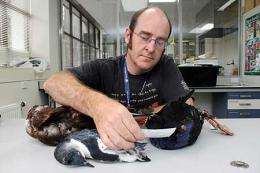Bird molecules challenge to Moa's Ark theory

(PhysOrg.com) -- The so-called "Moa's Ark" theory - that New Zealand's animal and plant life has evolved largely untouched over 80 million years since the Gondwana supercontinent broke up - is being challenged by new molecular evidence from native birds.
Dr Steve Trewick and Gillian Gibb, from the Institute of Natural Resources, have carried out a review of the molecular phylogenetic evidence for New Zealand’s bird life.
The study examined all available molecular data that has been used to explore the relatedness of birds around the world, including New Zealand species. This includes studies of now extinct birds including moa, some populations of kiwi, and the giant eagle.
According to the review of the data, Dr Trewick says we must continue to rethink the way the biota (animal and plant life) developed and recognise that it has changed considerably over time. “Many New Zealand birds are ecologically very distinctive,” he says, “But the makeup of the avifauna is composite and mixed in space and time. A very high proportion of birdlife in New Zealand has its origins in Australia, but others come from various other parts of the Pacific or northern regions.”
This observation supports the hypotheses of eminent biologists of the 1950-1970s, including Sir Charles Fleming and Robert Falla. It is also consistent with emerging understanding of the formation of the New Zealand islands, which are much younger than the separation of the now largely submerged Zealandia micro-continent from Australia and Antarctica about 80 million years ago.
Some species are so like those in Australia they cannot be distinguished even with molecular data. At the other extreme are some that certainly share ancestors with Australian species but are very different. For example, the giant eagle evolved within the last two million years and is most closely related to a small Australian eagle.
“Evolution can happen quickly given the right circumstances,” Dr Trewick says. “For example we now know that most moa species evolved in the last three or four million years, which is young compared to the earlier ideas that related diversification to a much older 80 million year history of New Zealand. Although flightlessness could indicate ancient evolution, the trait is in fact relatively common among birds throughout the world, especially on islands. Our own takahe is an example of a species that has evolved flightlessness in recent geological time, whereas its flying cousin the pukeko has arrived in New Zealand in the last few hundred years.”
This follows a review of carried out by Dr Trewick and Otago University's Dr Graham Wallis, which examined patterns of biodiversity in New Zealand and information about the origins of local plants and animals. A consistent finding is that the biota is much more youthful than previously thought, but is in keeping with up to date geological evidence on the age of New Zealand.
“One of the conundrums has been the gappiness of the New Zealand avifauna,” Dr Trewick says. “We have two honeyeaters but there are more than 70 in Australia, one kingfisher compared to 24 in Australia, two common birds of prey but there are far more nearby.
“The success of colonisation by various species is an area of research that needs much more intensive study. What features improve the success of colonisation, or is it all down to chance? Either way, we can continue to enjoy the wonderful fruits of evolution that have given us the kiwi, kakapo, huia and black robin.”
The paper Vicars, tramps and the assembly of the New Zealand avifauna: a review of molecular phlyogenetic evidence, was published in IBIS: The International Journal of Avian Science.
Provided by Massey University




















